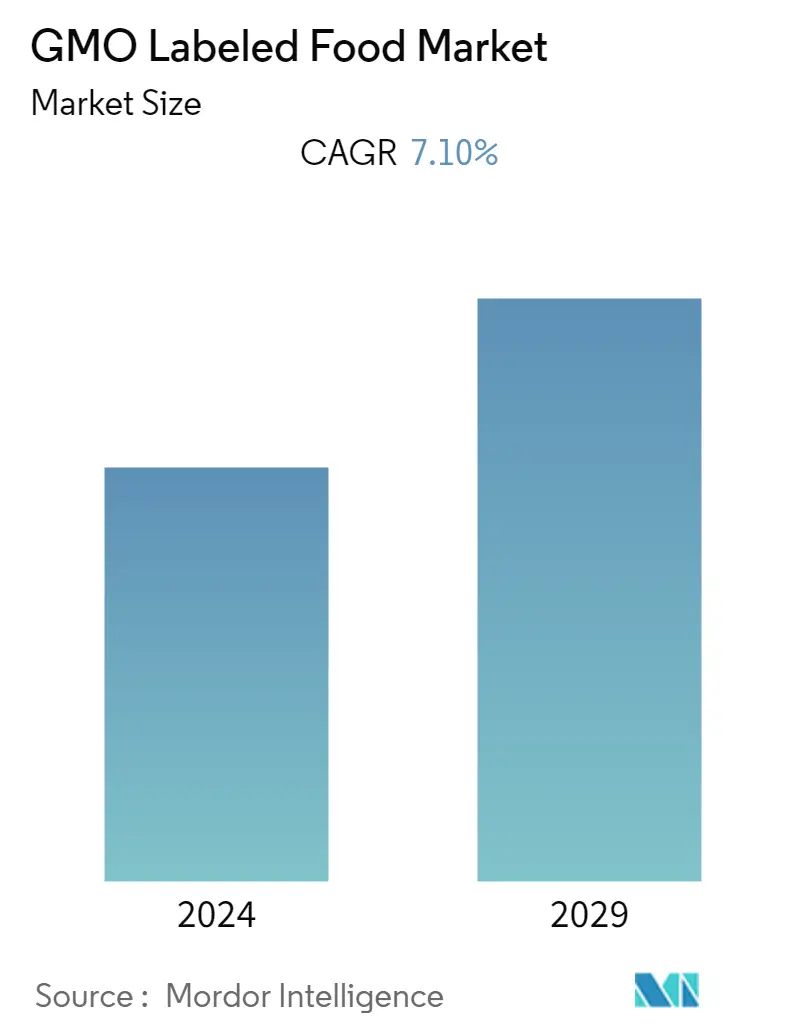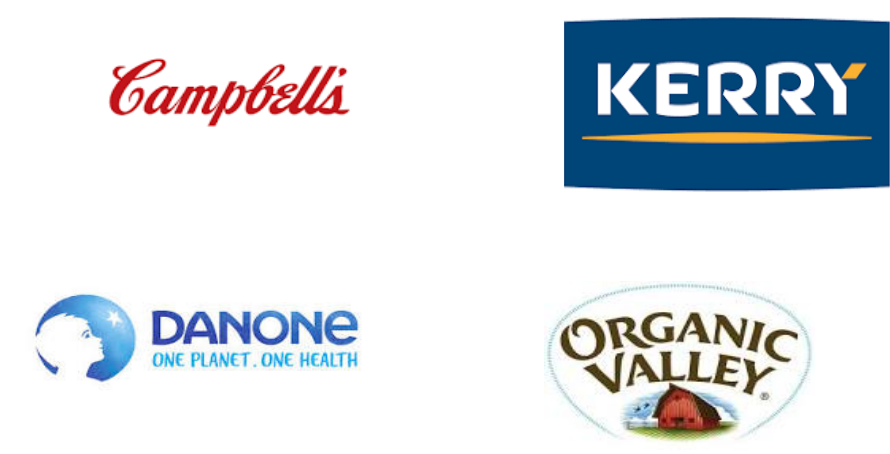Market Size of GMO Labeled Food Industry

| Study Period | 2019 - 2029 |
| Base Year For Estimation | 2023 |
| CAGR | 7.10 % |
| Fastest Growing Market | Asia Pacific |
| Largest Market | Europe |
| Market Concentration | Low |
Major Players
*Disclaimer: Major Players sorted in no particular order |
GMO Labeled Food Market Analysis
The GMO labeling market is expected to register a CAGR of 7.1% during the forecast period.
- With the increase in desire for clean labels and growing awareness of the ingredients used, the consumer demand for product's ingredient list, provenance, manufacturing process, shipping, storage, and safety standards, is rapidly growing.
- GMO Labeling includes origin, ingredient lists, warehouse, manufacturing process, shipping, and testing, which help the consumer to get the product they are purchasing and know what is in their food. According to a study by the Pew Research Center, 57% of Americans believe GMOs are unsafe to eat, and 67% of American support GMO labeling. This indicates that the consumers want to be informed about their product.
- Several government regulations are another driving factor behind GMO labeling. Countries like the European Union, Australia, and Japan have strict government regulations for GMO labeling. This growth in consumer awareness is immensely supported by various regulatory and non-government organizations, like Organic Consumers Association, etc., that actively create awareness and fight for the labeling rules for a product. Health and safety concern among consumers is the main factor behind GMO labeling.
GMO Labeled Food Industry Segmentation
GMO food labeling helps consumers make an informed choice about the food they buy by providing them with necessary information about GM ingredients on the food package.
The GMO labeled food market is segmented by type, distribution channel, and geography. Based on type, the market is segmented into processed food, meat & poultry, dairy, beverage, and others. Based on distribution channels, the market is segmented into supermarkets/hypermarkets, convenience stores, specialist stores, online retail stores, and other distribution channels. Also, the study analyzes the GMO-labeled food market in emerging and established markets worldwide, including North America, Europe, Asia-Pacific, South America, and the Middle East & Africa.
The report offers market sizes and values in (USD Million) during the forecast years for the above segments.
| By Type | |
| Processed Food | |
| Meat & Poultry | |
| Dairy | |
| Beverage | |
| Other Types |
| By Distribution Channel | |
| Supermarket/Hypermarket | |
| Convenience Stores | |
| Specialist Stores | |
| Online Retail Stores | |
| Other Distribution Channels |
| Geography | |||||||||
| |||||||||
| |||||||||
| |||||||||
| |||||||||
|
GMO Labeled Food Market Size Summary
The GMO-labeled food market is experiencing significant growth, driven by increasing consumer demand for transparency regarding food ingredients and safety standards. As consumers become more aware of the origins and manufacturing processes of their food, there is a growing preference for clean labels that provide detailed information about product provenance and safety testing. This trend is further supported by regulatory frameworks in regions like the European Union, Australia, and Japan, which enforce strict GMO labeling requirements. The demand for GMO labeling is also fueled by consumer concerns about health and safety, with many advocating for the right to know whether their food contains genetically modified organisms. This heightened awareness is bolstered by the efforts of various organizations that promote labeling rules and consumer education.
The market is characterized by a competitive landscape, with major players such as General Mills, Campbell Soup, Danone, Kellogg Company, and ConAgra Foods Inc. actively responding to consumer preferences for non-GMO foods. These companies are investing in new production lines and restructuring their operations to align with sustainability goals and meet the growing demand for labeled products. The European region, known for its mature economy and high consumer income, is witnessing robust growth in the GMO-labeled food market due to its stringent labeling regulations and consumer preference for health over price. As food manufacturers continue to innovate and adapt to these trends, the global GMO-labeled food market is expected to expand, driven by both technological advancements and increased consumer interest in food safety.
GMO Labeled Food Market Size - Table of Contents
-
1. MARKET DYNAMICS
-
1.1 Market Drivers
-
1.2 Market Restraints
-
1.3 Porter's Five Forces Analysis
-
1.3.1 Threat of New Entrants
-
1.3.2 Bargaining Power of Buyers/Consumers
-
1.3.3 Bargaining Power of Suppliers
-
1.3.4 Threat of Substitute Products
-
1.3.5 Intensity of Competitive Rivalry
-
-
-
2. MARKET SEGMENTATION
-
2.1 By Type
-
2.1.1 Processed Food
-
2.1.2 Meat & Poultry
-
2.1.3 Dairy
-
2.1.4 Beverage
-
2.1.5 Other Types
-
-
2.2 By Distribution Channel
-
2.2.1 Supermarket/Hypermarket
-
2.2.2 Convenience Stores
-
2.2.3 Specialist Stores
-
2.2.4 Online Retail Stores
-
2.2.5 Other Distribution Channels
-
-
2.3 Geography
-
2.3.1 North America
-
2.3.1.1 United States
-
2.3.1.2 Canada
-
2.3.1.3 Mexico
-
2.3.1.4 Rest of North America
-
-
2.3.2 Europe
-
2.3.2.1 United Kingdom
-
2.3.2.2 Germany
-
2.3.2.3 France
-
2.3.2.4 Russia
-
2.3.2.5 Italy
-
2.3.2.6 Spain
-
2.3.2.7 Rest of Europe
-
-
2.3.3 Asia Pacific
-
2.3.3.1 India
-
2.3.3.2 China
-
2.3.3.3 Japan
-
2.3.3.4 Australia
-
2.3.3.5 Rest of Asia-Pacific
-
-
2.3.4 South America
-
2.3.4.1 Brazil
-
2.3.4.2 Argentina
-
2.3.4.3 Rest of South America
-
-
2.3.5 Middle East & Africa
-
2.3.5.1 South Africa
-
2.3.5.2 United Arab of Emirates
-
2.3.5.3 Rest of Middle East & Africa
-
-
-
GMO Labeled Food Market Size FAQs
What is the current GMO Labeled Food Market size?
The GMO Labeled Food Market is projected to register a CAGR of 7.10% during the forecast period (2024-2029)
Who are the key players in GMO Labeled Food Market?
Campbell Soup, Danone, Kellogg Company, ConAgra Foods Inc. and General Mills are the major companies operating in the GMO Labeled Food Market.

